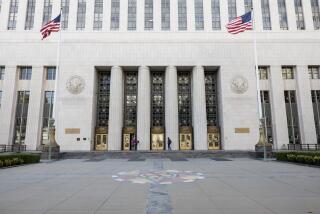In the Denny-Beating Trial, Potemkin Village Justice Has Reached Its Climax : Law: Until recently, the one place that judges would not--or could not--mess around was with juries. Now that prohibition has been violated.
The Reginald O. Denny-beating trial was the Los Angeles Superior Courtâs chance to âget it right,â right meaning to afford due process to the defendants while maintaining public confidence in the integrity of the judicial system. Instead, we get the judicial version of the rock group Queen doing âAnother (juror) gone . . . Another (juror) gone . . . Another (juror) bites the dust.â
Is the system somehow cheating? In a completely unscientific survey, I asked roughly a dozen defense lawyers in the Criminal Courts Building how many times they had lost jurors due to misconduct during deliberations. The results: Nobody had ever lost two jurors--as in the Denny-beating trial--in a single trial due to such misconduct. A few (including me) had lost one juror during deliberations due to misconduct, but the majority had lost none. Collective experience: Roughly 1,500 jury trials.
What it comes down to is that the criminal-justice system in Los Angeles has been caught with its pants down. It appears that the court is trying to force a verdict out of a jury that apparently was hung. The criminal-justice system, it seems, simply cannot weather the intense scrutiny that Henry Keith Watson, Damian Monroe Williams and Rodney G. King have brought to it.
So how did the largest court system in the United States get to the point where the exercise of judicial discretion resulted in the worst riots in the 20th Century? And how can the same justice system then obliviously come back with a sequel that suspiciously looks like magician David Copperfield making jurors disappear?
For the last four or five years, we have been doing Potemkin Village justice in Los Angeles, which means a defense attorney brings various motions about the unfairness or illegality of one thing or another, and the judge appears to seriously consider the motion before denying it. This afforded the defendant the illusion that he or she was getting due process, the judge the illusion that he or she was giving due process, and the lawyer the benefit of paying the mortgage.
Until recently, the one place that judges would not--or could not--screw around was with juries. The decision as to whether the defendant broke the law or not belonged, wholly and completely, to 12 folks off the street, or, as in the Denny-beating trial, the 13, 14, 15, 16 or 17 people off the street, since the court has gone through five alternates.
In any case, jury trials were just about the only thing that were tamper-proof. Now that appears to have ended as well.
Judging by the transcripts of the closed hearings to decide the fate of a Denny-trial juror, Juror 373, an older black woman, enraged her fellow jurors because she insisted on being extremely cautious. Still, the jury apparently reached two verdicts before she was removed for ârefusing to deliberate.â How did they reach two verdicts if she was refusing to deliberate?
We also learned that Juror 104, a young white woman, spent a large part of the deliberations pining for her boyfriend. She reportedly ran down the hall of the hotel where the jury is sequestered screaming that a hung jury was OK by her as long as she could see her boyfriend. Responding to her apparent frustration, the court ordered increased âpersonalâ visitation time for the jury, but denied defense attorney Edi O. Faalâs motion to have Juror 104 removed. Reportedly, she feels much better now.
The Watson-Williams jury dilemma is generated by the breakdown of the judicial âfeedback loop.â The community--the local, national and, for that matter, international--made it clear that fairness and due process had to be impeccably observed in the Denny-beating trial. But what conceivable segment of the public would think that fairness could be enhanced by removing a juror at the request of other jurors? Where is the precedent for removing a juror who has already reached some verdicts, or for vacating the verdicts that had been reached? Outside of those few appellate decisions ratifying the trial judgeâs âbroad discretion,â the area of juror removal is virtually a legal vacuum.
The judicial branch of government draws its legitimacy from the Constitution and the community. Even if an appellate court finds that the trial judge did not abuse his discretion, that is not the same as the judge having properly exercised that discretion in the first place.
If convictions result, the appeals process will go on for years. The dismissal of Juror 373 alone creates novel questions of double jeopardy. As for the solution to Juror 104âs problems . . . well, thereâs only so much the judiciary can do.
The clouds associated with the Denny-beating trial--and by association, the 1992 riots--will continue to hang over Los Angeles. The defendants will languish in jail while their lawyers attempt to get a new trial.
In the more momentous U.S. Supreme Court arguments, Chief Justice Earl Warren was fond of asking lawyers a simple question: âIs it fair?â
On the integrity of the Denny-trial process, the public has deliberated and reached its verdict.
We lost.
More to Read
Sign up for Essential California
The most important California stories and recommendations in your inbox every morning.
You may occasionally receive promotional content from the Los Angeles Times.










